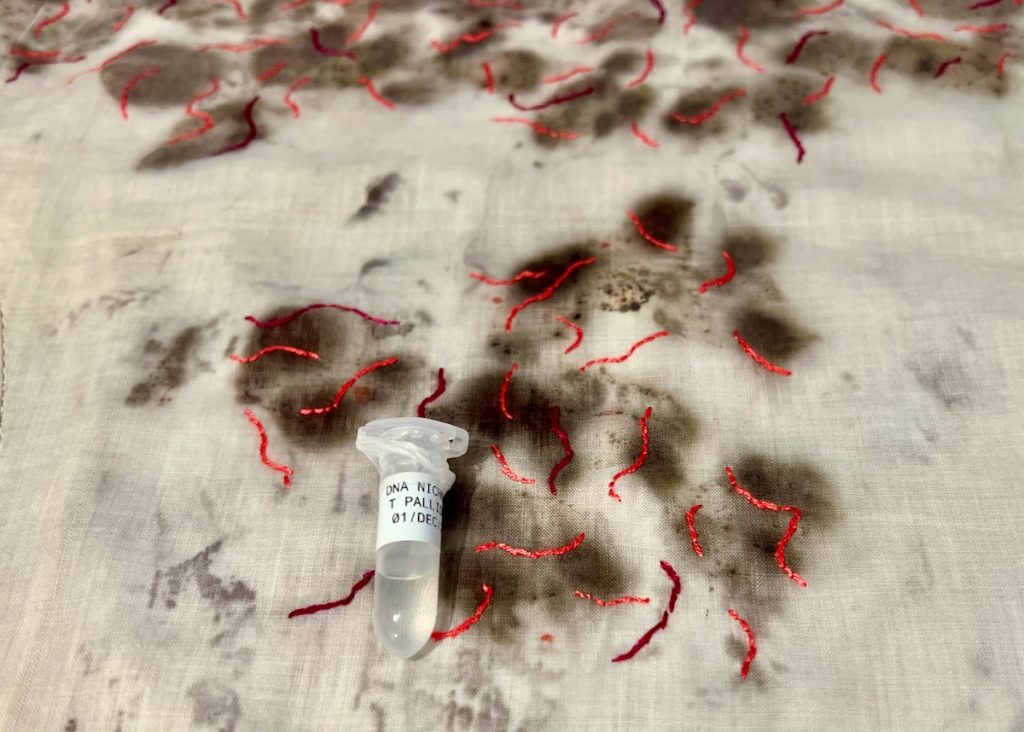The Syphilis Dress (2023) stems from a collaboration with Dr Linda Grillova, George Lacey, MSc, and Professor Nicholas Thomson exploring the history and future of Treponema pallidum subsp. pallidum, the bacterium that causes syphilis, known as ‘The Great Pox’.

The dress is embroidered with images of the bacterium observed in the laboratory and those embroideries are impregnated with the DNA of Treponema pallidum subsp. pallidum strain Nichols extracted by the artist under the supervision of Grillova and Lacey. This DNA is non-infectious.
The use of an antique Edwardian woman’s cotton underdress adds historical context as syphilis was commonly hidden and frequently blamed on female sex workers, though more often highly stigmatised sexually transmitted disease was passed from husbands to wives and sadly from mothers to their babies in congenital infections. If untreated, syphilis can lead to multiple organs being damaged, resulting in severe conditions. Despite the availability of effective treatment, the last decade has witnessed a dramatic global re-emergence of this disease, with the annual worldwide incidence reaching more than 5.6 million. With no effective vaccine developed, the only prevention of syphilis that remains is sexual abstinence, condom use and intensive screening.

The period garment also references the fact that the strain Nichols was first extracted from a male patient with neuro-syphilis (infection of the central nervous system) in 1912. That strain has been kept alive in experimental animals (rabbits) by scientists in the USA for around 110 years, but recently it has become possible to culture Treponema pallidum subsp. pallidum in vitro. This possibility opens up many new research directions which are now being studied by the team here.
The underdress is botanically printed with eucalyptus leaves, used as a remedy for syphilis, the pestle and mortar are made from lignum vitae (the wood of life), a hardwood gained popularity in the sixteenth century as an ingredient in the treatment of syphilis though it was ineffective in this capacity. Similarly ineffective were the pungent contents of the mortar, Sarsaparilla, sold as a remedy for syphilis in the USA in the nineteenth century. Mercury was also a popular ‘cure’ for syphilis since the 1400s, although we now regard it as too toxic to use. The first modern scientific treatment for the disease was created by Paul Ehrlich in 1910, and later an improved version Neosalvarsan in 1912 (the same year the strain Nichols was collected). Nowadays the disease can be treated with penicillin.
In collaboration with scientists Dr. Linda Grillova, George Lacey, and Professor Nicholas Thomson. Supported by the Arts Council England and the European Union’s Horizon 2020 research and innovation programme under the Marie Skłodowska-Curie grant agreement No. 895136.
Materials: Edwardian cotton underdress, embroidery silk, botanical printing with madder soaked eucalyptus with ferrous sulphate dip, and DNA of Treponema subsp. Treponema strain Nichols, Unopened Neosalvarsan, Lignum vitae wood pestle and mortar, and sarsaparilla root.
Exhibitions

Wellcome Sanger, Hinxton near Cambridge (UK), as part of Works by Anna Dumitriu, 12th January – 28th February 2023.

BioArt Revolution/ Revoluția BioArt, an innovative solo exhibition by Anna Dumitriu which took place as part of Timișoara 2023 European Capital of Culture, from 30th September to 1st October 2023. The exhibition, which was created in collaboration with the Romanian Science Festival, took place at Bastionul Maria Theresia, Galeria 2, Str. Hector, nr. 1, Timișoara, Romania.
BioArt Knowledge: A Solo Exhibition by Anna Dumitriu at the Yarrow Gallery in Oundle, Near Peterborough, UK, from 9th November – 6th December 2023.

Fragile Microbiomes (solo exhibition) at the Thackray Museum of Medicine, Leeds, UK, from 10th February to 23rd June 2024.
